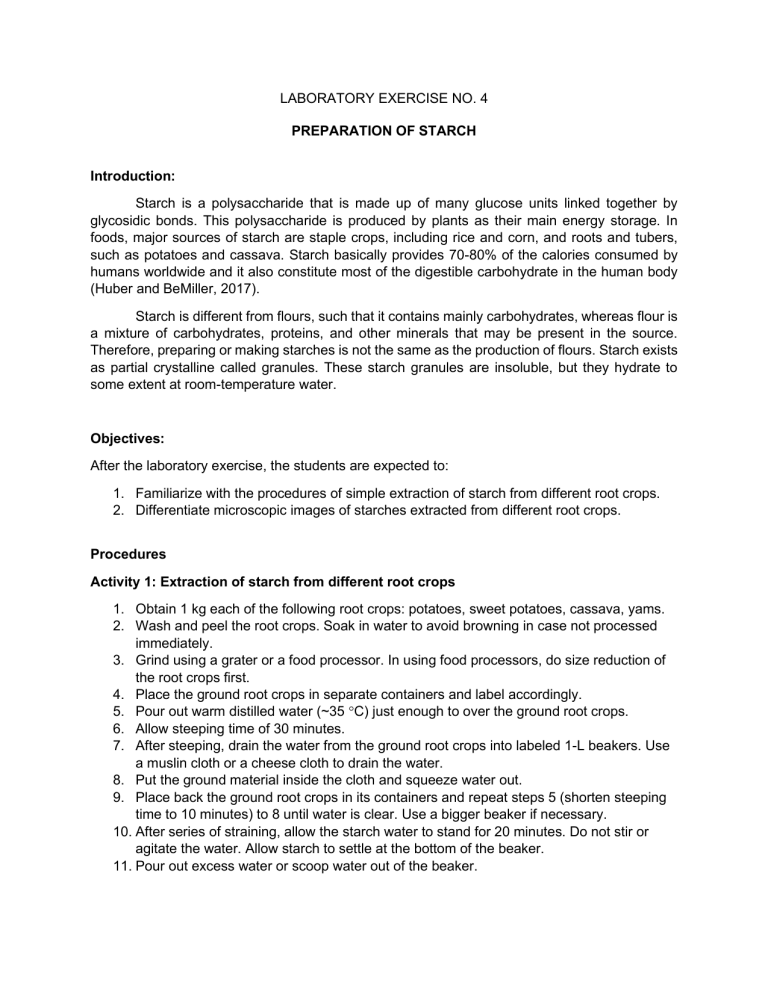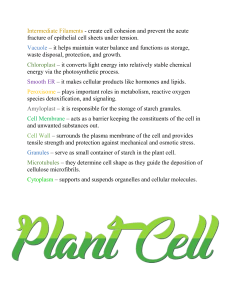
LABORATORY EXERCISE NO. 4 PREPARATION OF STARCH Introduction: Starch is a polysaccharide that is made up of many glucose units linked together by glycosidic bonds. This polysaccharide is produced by plants as their main energy storage. In foods, major sources of starch are staple crops, including rice and corn, and roots and tubers, such as potatoes and cassava. Starch basically provides 70-80% of the calories consumed by humans worldwide and it also constitute most of the digestible carbohydrate in the human body (Huber and BeMiller, 2017). Starch is different from flours, such that it contains mainly carbohydrates, whereas flour is a mixture of carbohydrates, proteins, and other minerals that may be present in the source. Therefore, preparing or making starches is not the same as the production of flours. Starch exists as partial crystalline called granules. These starch granules are insoluble, but they hydrate to some extent at room-temperature water. Objectives: After the laboratory exercise, the students are expected to: 1. Familiarize with the procedures of simple extraction of starch from different root crops. 2. Differentiate microscopic images of starches extracted from different root crops. Procedures Activity 1: Extraction of starch from different root crops 1. Obtain 1 kg each of the following root crops: potatoes, sweet potatoes, cassava, yams. 2. Wash and peel the root crops. Soak in water to avoid browning in case not processed immediately. 3. Grind using a grater or a food processor. In using food processors, do size reduction of the root crops first. 4. Place the ground root crops in separate containers and label accordingly. 5. Pour out warm distilled water (~35 °C) just enough to over the ground root crops. 6. Allow steeping time of 30 minutes. 7. After steeping, drain the water from the ground root crops into labeled 1-L beakers. Use a muslin cloth or a cheese cloth to drain the water. 8. Put the ground material inside the cloth and squeeze water out. 9. Place back the ground root crops in its containers and repeat steps 5 (shorten steeping time to 10 minutes) to 8 until water is clear. Use a bigger beaker if necessary. 10. After series of straining, allow the starch water to stand for 20 minutes. Do not stir or agitate the water. Allow starch to settle at the bottom of the beaker. 11. Pour out excess water or scoop water out of the beaker. 12. Add enough warm distilled water to the starch in the beaker, allow to stand for another 20 minutes, and pour the water out. 13. You should have a paste-like starch mixture. 14. Dry wet starch by spreading it a foil in a flat surface. Dry in an oven dryer at 35 °C for 5 hours. Constantly check the starch if it is already dry. 15. After drying, homogenize the starch using a grinder. 16. Keep the dry starch and label accordingly. 17. Record the weight of the extracted starch and compute for percent yield using the formula: 𝑤𝑡 𝑜𝑓 𝑑𝑟𝑦 𝑠𝑡𝑎𝑟𝑐ℎ % yield = 𝑖𝑛𝑖𝑡𝑎𝑙 𝑤𝑡 𝑜𝑓 𝑟𝑜𝑜𝑡 𝑐𝑟𝑜𝑝 x 100 18. Note the appearance, color, and texture of the different starches. 19. Perform the iodine test. Take a small amount of the extracted starch and place in a glass petri plate. Add one drop of 1N HCl and two drops of 2% KI solution. Formation of blue color indicates presence of starch. Activity 2: Microscopic observation of the starches. 1. Take the prepared starches in Activity 1. 2. Use a commercial cornstarch as the control. 3. Prepare starch paste by adding distilled water to the dry starch. Weigh 30 g of starch and slowly add 50 mL distilled water while continuously stirring until no lumps are present. 4. Place a thin smear of the starch paste in a glass slide. 5. Stain with 2% KI solution. 6. Observe under the microscope. 7. Sketch the shape, size, and color of the starch granules. Unbranched starch molecules (amylose) will appear blue while branched starch molecules (amylopectin) will appear reddish-black color. Activity 3. Preparation of roux 1. Prepare roux using the extracted starch and purchase a cornstarch to be used as control. 2. Heat 2 tablespoons of butter in a pan over low to medium heat. 3. Add 2 tablespoons of the starch into the melted butter. 4. Stir constantly until a liquid slurry is formed. 5. Keep heat to low setting once the slurry has formed. 6. Stop cooking once the color has become peanut butter brown. Try to make cooking time as similar as possible for all starches. 7. Remove from heat immediately. 8. Transfer to a container and allow to cool. 9. Compare the consistency and texture of roux made with the different starches. Guide Questions for Discussion 1. Explain the principles for each step of starch extraction. 2. Compare the percent yield of starch from the experiment with literature results. What are the possible sources of error committed during the laboratory exercise? 3. What could be the reason for the different starch contents of various root crops? 4. Illustrate the chemical reaction of starch and iodine observed during the iodine test. 5. Differentiate amylose and amylopectin in terms of structure, physical properties, and functional properties. References Huber, K.C. and BeMiller, J.N. 2017. Carbohydrates. In Damodaran, S. and Parkin, K. (eds). Fennema’s Food Chemistry, 5th edition (pp. 92-169). CRC Press, FL. Weaver, C.M. and Daniel, J.R. 2005. The Food Chemistry Laboratory: A manual for experimental foods, dietetics, and food scientists. CRC Press, FL.








